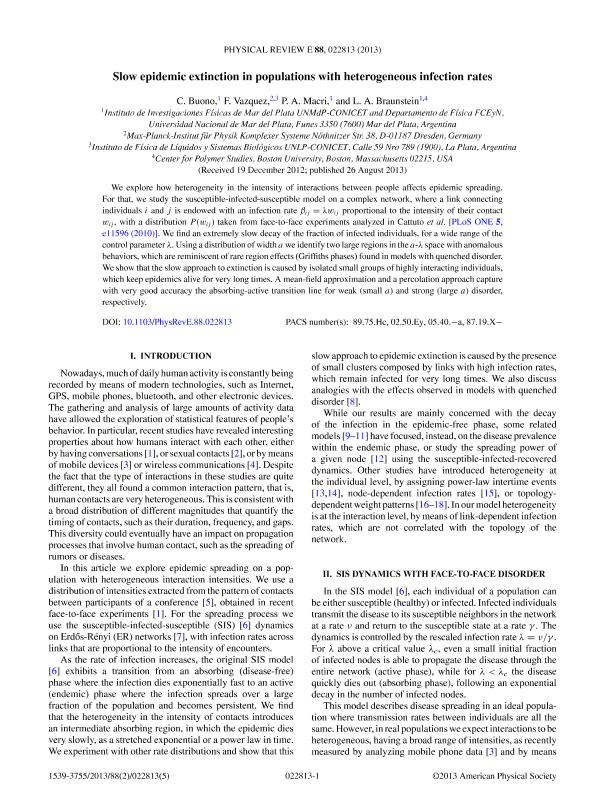Artículo
Slow epidemic extinction in populations with heterogeneous infection rates
Fecha de publicación:
08/2013
Editorial:
Amer Physical Soc
Revista:
Physical Review E
ISSN:
2470-0045
e-ISSN:
2470-0053
Idioma:
Inglés
Tipo de recurso:
Artículo publicado
Clasificación temática:
Resumen
We explore how heterogeneity in the intensity of interactions between people affects epidemic spreading. For that, we study the susceptible-infected-susceptible model on a complex network, where a link connecting individuals i and j is endowed with an infection rate β i j = λ w i j proportional to the intensity of their contact w i j , with a distribution P ( w i j ) taken from face-to-face experiments analyzed in Cattuto et al. [PLoS ONE 5, e11596 (2010)]. We find an extremely slow decay of the fraction of infected individuals, for a wide range of the control parameter λ . Using a distribution of width a we identify two large regions in the a − λ space with anomalous behaviors, which are reminiscent of rare region effects (Griffiths phases) found in models with quenched disorder. We show that the slow approach to extinction is caused by isolated small groups of highly interacting individuals, which keep epidemics alive for very long times. A mean-field approximation and a percolation approach capture with very good accuracy the absorbing-active transition line for weak (small a ) and strong (large a ) disorder, respectively.
Palabras clave:
Desorden
,
Redes
,
Complejas
Archivos asociados
Licencia
Identificadores
Colecciones
Articulos(IFIMAR)
Articulos de INST.DE INVESTIGACIONES FISICAS DE MAR DEL PLATA
Articulos de INST.DE INVESTIGACIONES FISICAS DE MAR DEL PLATA
Articulos(IFLYSIB)
Articulos de INST.FISICA DE LIQUIDOS Y SIST.BIOLOGICOS (I)
Articulos de INST.FISICA DE LIQUIDOS Y SIST.BIOLOGICOS (I)
Citación
Buono, Camila; Vazquez, Federico; Macri, Pablo Alejandro; Braunstein, L. A.; Slow epidemic extinction in populations with heterogeneous infection rates; Amer Physical Soc; Physical Review E; 88; 2; 8-2013; 22813-22814
Compartir
Altmétricas




